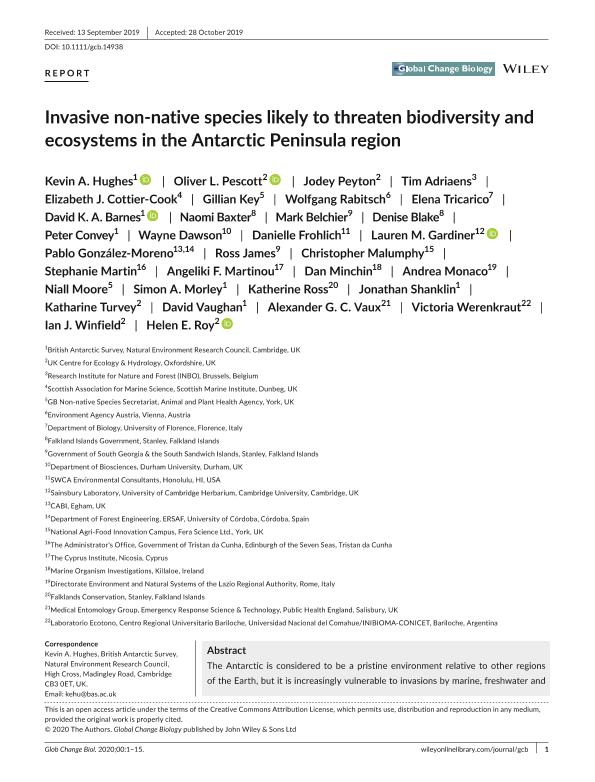Artículo
Invasive non-native species likely to threaten biodiversity and ecosystems in the Antarctic Peninsula region
Hughes, Kevin A.; Pescott, Oliver L.; Peyton, Jodey; Adriaens, Tim; Cottier Cook, Elizabeth J.; Key, Gillian; Rabitsch, Wolfgang; Tricarico, Elena; Barnes, David K. A.; Baxter, Naomi; Belchier, Mark; Blake, Denise; Convey, Peter; Dawson, Wayne; Frohlich, Danielle; Gardiner, Lauren M.; González Moreno, Pablo; James, Ross; Malumphy, Christopher; Martin, Stephanie; Martinou, Angeliki F.; Minchin, Dan; Monaco, Andrea; Moore, Niall; Morley, Simon A.; Ross, Katherine; Shanklin, Jonathan; Turvey, Katharine; Vaughan, David; Vaux, Alexander G. C.; Werenkraut, Victoria ; Winfield, Ian J.; Roy, Helen E.
; Winfield, Ian J.; Roy, Helen E.
 ; Winfield, Ian J.; Roy, Helen E.
; Winfield, Ian J.; Roy, Helen E.
Fecha de publicación:
04/2020
Editorial:
Wiley Blackwell Publishing, Inc
Revista:
Global Change Biology
ISSN:
1354-1013
Idioma:
Inglés
Tipo de recurso:
Artículo publicado
Clasificación temática:
Resumen
The Antarctic is considered to be a pristine environment relative to other regions of the Earth, but it is increasingly vulnerable to invasions by marine, freshwater and terrestrial non-native species. The Antarctic Peninsula region (APR), which encompasses the Antarctic Peninsula, South Shetland Islands and South Orkney Islands, is by far the most invaded part of the Antarctica continent. The risk of introduction of invasive non-native species to the APR is likely to increase with predicted increases in the intensity, diversity and distribution of human activities. Parties that are signatories to the Antarctic Treaty have called for regional assessments of non-native species risk. In response, taxonomic and Antarctic experts undertook a horizon scanning exercise using expert opinion and consensus approaches to identify the species that are likely to present the highest risk to biodiversity and ecosystems within the APR over the next 10 years. One hundred and three species, currently absent in the APR, were identified as relevant for review, with 13 species identified as presenting a high risk of invading the APR. Marine invertebrates dominated the list of highest risk species, with flowering plants and terrestrial invertebrates also represented; however, vertebrate species were thought unlikely to establish in the APR within the 10 year timeframe. We recommend (a) the further development and application of biosecurity measures by all stakeholders active in the APR, including surveillance for species such as those identified during this horizon scanning exercise, and (b) use of this methodology across the other regions of Antarctica. Without the application of appropriate biosecurity measures, rates of introductions and invasions within the APR are likely to increase, resulting in negative consequences for the biodiversity of the whole continent, as introduced species establish and spread further due to climate change and increasing human activity.
Archivos asociados
Licencia
Identificadores
Colecciones
Articulos(INIBIOMA)
Articulos de INST. DE INVEST.EN BIODIVERSIDAD Y MEDIOAMBIENTE
Articulos de INST. DE INVEST.EN BIODIVERSIDAD Y MEDIOAMBIENTE
Citación
Hughes, Kevin A.; Pescott, Oliver L.; Peyton, Jodey; Adriaens, Tim; Cottier Cook, Elizabeth J.; et al.; Invasive non-native species likely to threaten biodiversity and ecosystems in the Antarctic Peninsula region; Wiley Blackwell Publishing, Inc; Global Change Biology; 26; 4; 4-2020; 2702-2716
Compartir
Altmétricas



